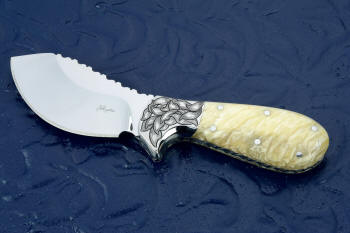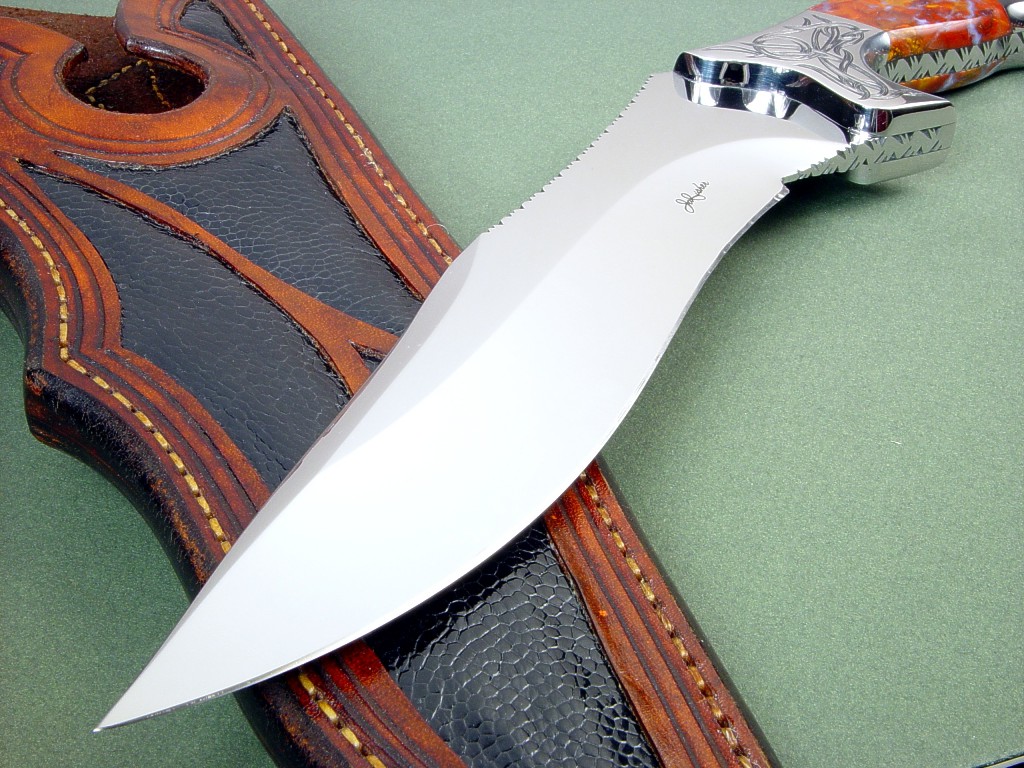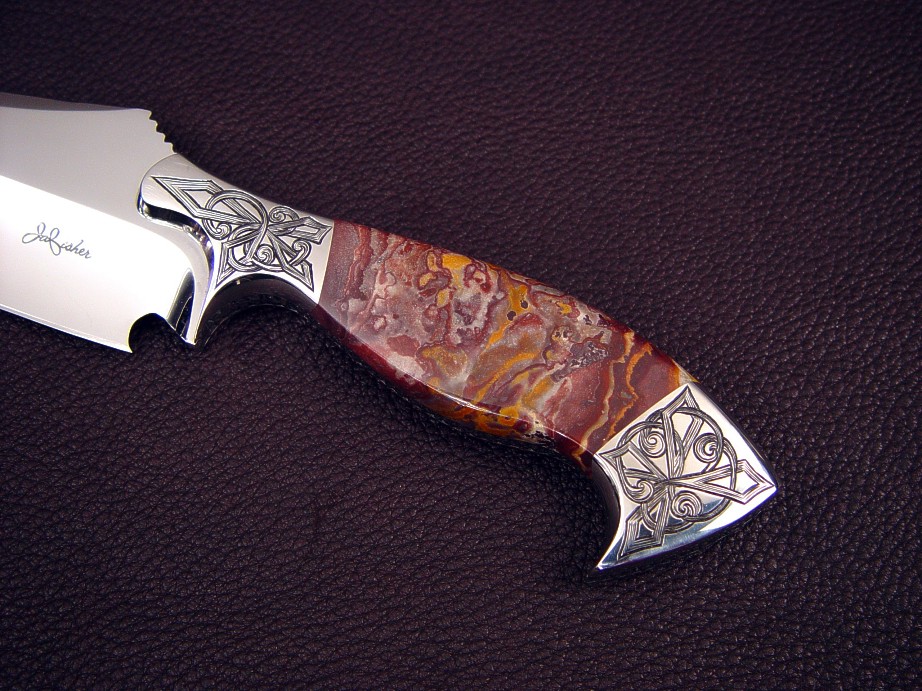Overview of the Modern Knife Maker
Modern Knife Making by Individuals
This page offers an overview of the modern singular knife maker. This page does not discuss
factories, boutique shops, or other ventures where groups of people, corporations, or businesses
employing more than one individual manufacture knives. This is about the individual modern knife
maker and the terms, type of work, techniques, scope of business, and direction of art that modern knife making
offers for the individual craftsman and artist.
The modern knife maker makes knives, of course. There is,
unfortunately, no fashionable or more elegant term
for the person who makes knives. When the term knifemaker is used in contemporary
times, it usually refers to an
individual, working in a shop or studio, creating knives, daggers,
swords, or other edged tools and weapons from raw materials. The
term knifemaker is a neologism, a new word that means so much more than
the word knife and maker do separately. There are many
types of knifemaker (sometimes casually referred to as the maker), and the maker's level of involvement
varies. The first distinction is that level of involvement.
- Hobbyist: People often start out
making knives as a hobby. They may purchase kits to finish and
assemble, may be given old knives to repair or refurbish, or may
make knives from found materials like steel scrap or wood cutoffs.
They may work with a minimum amount of tools, sometimes in a small
shop or garage (hence the term garage-maker) and enjoy the interest of knife making.
This is how I started making knives in 1978-9: as a hobby. My first
knives were given away.
- Part-time knife maker: Part-time makers are
usually more serious than hobbyist makers, and are actively selling
what they make. Knife making is not their main vocation though, and
they derive income from another source, job, or retirement, which
often is essential to furthering their part-time knife making.
Incidentally, these are most of the knifemakers you may encounter on
the Internet, at shows and exhibitions, and in publications. They
may work in a small or large shop with minimal equipment or large
investments of complex machinery, depending on the type of knife
they make and sell. They may spend only a moderate amount of
time making knives, or may be deeply involved investing huge amounts
of time, up to as much time as a full time job. I was a
part-time knifemaker for about 8 years, before I went full time.
- Professional Knife Maker: Also called
full time knifemakers, this defines knife makers that have chosen
the field of knife making as their job or vocation. Their level of
involvement is extremely high, and as professionals they derive their main income from
making and selling knives. They must have a well-equipped,
professional shop or studio, often have an active and viable
business store front in their community, and vigorously participate in the
business of making and selling knives year after year. Their
involvement can be so high and expansive that they also
professionally consult for other businesses, organizations,
military, and professionals. This is
what I am now, and have been since 1988. I take my profession seriously, and it is how I derive all of my
income for my family and myself. This is my regular job, and I love
it!
- Career Knifemaker:
This is a professional knifemaker who has made an entire career of
making knives. I had to include this term to celebrate 2018, which
is my 30th year of being a full time professional custom knifemaker.
This is my career, and I'm honored that I've been given the chance
to serve others for so long. Just because I've had a full career of
knifemaking, it doesn't mean it's over. In fact, some of the very
best work I'll ever do is being done right now, in 2018, and next
year, and the years after that!
I have been a professional full time knifemaker since 1988.
Back to topics

There are several specific distinctions that describe how the modern
knife is made that are important: handmade or custom, and other terms
that are more general.
- A handmade knife is generally
described as a knife that is made offhand. What this means in detail
is that human hands must be in control of all the functions of knife
making, like holding the hammer that forges the knife, holding the
blade against the grinder, guiding the drilling, milling, and
shaping by direct control of the hand. What this term excludes is
any activity that is automated, where the blade or component is
clamped in a fixture and an automated machine, such as a computer
numerically controlled milling machine (CNC mill) automatically
cuts, shapes, and forms the component. The advantage to handmade
knives is that subtle nuances of control in the machining and
finishing can occur, leading to a much more desirable and often
better made product. There is a reason you don't see finely finished
knives coming out of a computer automated device. I go into that in
greater detail in my upcoming book.
- A custom knife by exact definition is
a knife made to a customer's order. These are knives that are
commissioned by clients with specific features and details and
are created by the knife maker for that client. While a knife may be
handmade and custom, a knife that is not specifically ordered for a
specific client may be handmade, but is not custom. There is a lot
of lax usage of the word custom on the Internet, in discussions,
and in publications. There are even major knife shows that have
the word custom in their name, yet the participants in the
show do not sell custom knives, but knives made and created to sell
to the public at large, in essence, inventory knives. The only way
these shows could be called custom is if the knives at the show are
ordered by and made individually unique for each client coming to
the show. Why would these interests hijack the word? I believe this is because the word custom
denotes a higher level of participative quality. If a knife maker
makes custom knives, that means he is capable of a wide variety of
process and a high level of skill, in that clients seek him out and
offer direct commissions, whereas a non-custom maker simply makes
and sells knives made by his own design. Read more about the
custom knife description on my
Custom Knives Page
- Other terms are varied and non-specific like bench made
which is a term that once was used to denote a knife
that is made on a tool bench and not by automated process, though
that can be vague description. Are knives made on a tool bench
simply assembled from components manufactured overseas? Because
the term is associated with a knife factory, the term
has fallen out of favor and has lost meaning in the modern knife
world, and is best avoided altogether. Other terms prevalent in this
industry are boutique shop, custom shop,
production facility. What do you call a knife made
in a small factory or by a group of people in a boutique shop, small
factory, or manufacturer? Why a factory knife or manufactured knife,
of course, because that is what it is.
It is not custom, not handmade, and not unique or original but a
mass produced and manufactured product. The reason for these
curious names for knife manufacturers is one of advertising only.
More information about this topic on my Business of Knifemaking
at this bookmark.
Please remember that there is no right or wrong way
to make a knife, only different methods. The source of
the knife should clearly and easily define how the
knives are made, where the components come from, and who
supplies them as well as the processes used and their
origin, and the alloys and components of construction
that are recognized by official entities like the AISI
(American Iron and Steel Institute), ASME (American Society of
Mechanical Engineers), and SAE (Society for
Automotive Engineers).
Back to topics
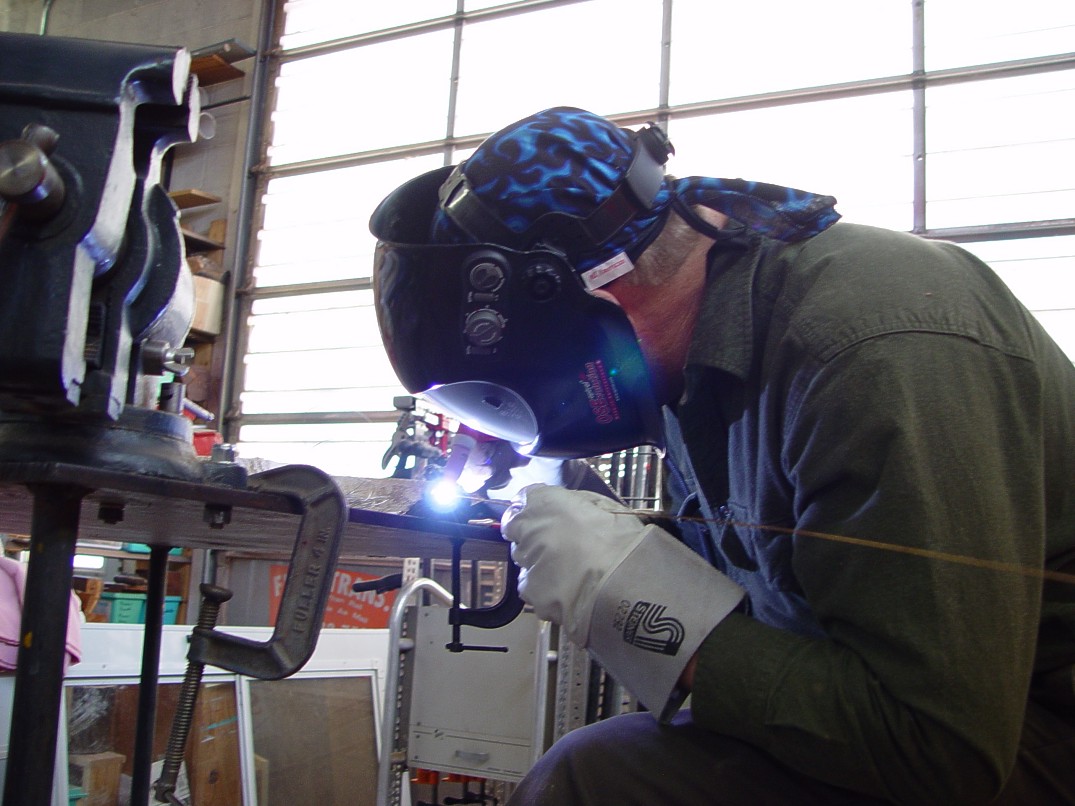
It's interesting to see the confusion about the simple word handmade,
and this has gone on for decades in our profession. People who buy fine
knives obviously prefer handmade knives, since there really is no finely
made and highly priced collector's grade factory or machine-made knife.
There are no extremely finely made combat knives made by machine either,
and that escapes most people who do not realize that there is a large
demand for an extremely high quality tool and defensive weapon that is
necessary in combat, counterterrorism, search and rescue, and emergency
situations. It's
common knowledge that the minute a particular operation is handed over
to a machine, and taken from the control of the human hand, the product is less
desirable and less valuable overall.
The reason for this is simple: a
machine has very specific operations, and very specific and controlled
functions, and has no ability to create, grow, advance, learn, and
improve the product it creates. It simply repeats a function, over and
over, usually at great speed. Because of this automation,
machine-produced products are cheap. Creating cheap products means that
they must be sold in great volumes, and since most of the world does not
have significant money to spend on knives, the masses only buy cheap
knives. Machine-made and machine-produced products are and will always
flow in a downward fashion, when concerned with quality, price, and
options.
Machines are created by man for many reasons, but let's just look at
one: drudgery. When I think of the word drudgery, I think of a flock of
sweaty, laboring women crouching at the edge of a stream, pounding
clothes on rocks to wash them. The clothes are filthy because they
belong to their men, who are sweaty and laboring in the fields, guiding
a plow, bent over, pulling weeds, prying big rocks out of the earth so
the crops to come will flourish. This was the plight of my ancestors
here in this country, dating back to the Revolutionary War times. Most
of my ancestors, when researched far back enough, were farmers,
laboring, sweating, working, and suffering to stay alive. Most people
can claim this.
This is the main reason machines were created, to make easier and
faster the labor, particularly repetitive, monotonous, difficult labor
like washing clothes and tilling soil. In knifemaking, one of the most
laborious, wearisome, and repetitive operations is cutting
out steel, or blanking. The reason is because even in the annealed and
softened state, cutting must commence slowly, with some force and plenty
of control, particularly in the higher alloy steel types. Since metal
cutting bandsaws mostly cut straight lines, this is a particularly
frustrating experience to produce highly curved forms. Do you then
wonder why most knives are fairly straight pieces of flat metal bars?
What about the bolsters, those little, thick, tenacious blocks of metal
everyone wants to eliminate, simply because they are so difficult to
produce? More about
Bolsters here.
For knifemakers, sawing or blanking blades can become a wearisome
issue. I've seen makers do just about anything to not have to saw out a
blade, including employing plasma cutters, grind-profiling, water
jetting, and even convincing their wives to push metal through their
bandsaws (I'm not kidding)! Rather than approach the problem head-on,
they want to make it easier, and that's understandable. They want to get to
the fun stuff, the part of knifemaking that makes a bar of steel look
like a knife, the grind, and the handle (mostly the handle, since wood,
horn, bone, and plastic is far easier to work than metal). In the last
decade, with the advancement and availability of the computer aided
design (CAD) programs and computer aided machining (CAM) operations,
would-be knifemakers can simply sit on their fluff at a computer monitor
and mouse, click up a design (and call it "work") and then email their
creation to a company that will cut out their blades with a water jet,
and sent them the blanks. I see this more and more in our trade,
and it's easy to see why; it's simply easier. But as in
this section on my "Heat Treating and Cryogenic Processing of Knife
Blade Steel" page, easier and cheaper is not a good road to embark on,
if the journey is to lead to a successful artistic and desirable knife
profession.
When they have knives cut out with a water jet, they may be surprised
to learn that they and their knives are not welcome at knife shows, and
they can be looked down upon by other makers. There are a few distinct
points to this.
- The first is the word "custom" and it's misuse
to describe a handmade knife show. This has been going on
for decades, and it's not likely to stop, but there are no "custom"
knife shows, even though they claim to be. Custom means
made to order, and the knives at most of these shows are
handmade. Usually, the word handmade conjures up images of folk
craft: quilts, barn decor, furniture made from rough branches, and
blue bottle trees. Seriously, put the term "blue bottle tree" into a
search engine and look at the images; what an incredible fascination
with this form and color! In any case, the word handmade is
less desirable than the word custom in the public show
venues, so custom is
the standard misuse at these events. More about that on my Custom Knives page.
- Handmade knives only. This has been
ongoing for decades, and the concept is this: as more
knife shows appeared in the 1980s, knifemakers in organizations (the
Knifemakers Guild, the American Bladesmith Society, the Professional
Knifemaker's Association) were confronted with more makers who were
surrendering their operations (the creation of their knives) to
machines. There were some pretty big-name makers doing this, and
they would have bits, pieces, and components even farmed out to
outside contractors while they did the assembly of the knives. These
knives they then called "handmade" in order to qualify for shows. I
know we had quite a huge split in the Knifemakers Guild about this
classification and qualification at that time, as these essentially
machine-made products were being called "handmade," in direct
conflict with show rules and the direction of the organization. I'll
go into this more in my book, but the members then demanded that at
the very least, documents (certificates of origin) were required so
that the method of knifemaking employed was disclosed to potential
buyers of the knives presented at these shows. Even today, some
shows require that operations of knifemaking be disclosed. Some of
the shows prohibit knives for sale that are even partially made by
machine control, and that includes water-jetting blades.
- Machines and machine control: Some people get
confused by this. Machines are used to make knives, nearly every
knife you see has, at one time, been touched by a machine. Even guys
who hand-forge are using machines: electric fan-driven forges,
machine welders, power trip hammers, hydraulic presses, and
grinding/sanding/finishing of at least one component of the knife
ensemble. So, with very few exceptions, we are all using machines.
The distinction is with machine control. When control of the machine: positioning,
movement, indexing, motion, action, or any operation of the machine
is controlled by a computer, it is no longer considered handmade.
Holding a blade by hand against a grinder qualifies as handmade,
because all of the grinding is directly controlled by human hands. Having a blade clamped to a tooling plate while a
computer-controlled CNC (computer numerical control) machine moves a
cutter against the blade is not handmade, even though a hand guided
a computer mouse in clicking out the design. Neither handmade is a
blade blank that is clamped against a table while a computer moves a
water jet (high pressure water cutting device) around the periphery
to create a blade blank. It's pretty easy to understand. If
any part of the making of the knife is under the control of a computer or
automated system, it's not entirely handmade.
When new makers are confronted with this, they are often upset. After
all, the rest of the knife is handmade; why is it important how the
blade is cut out? After all, it's only one operation, one step.
This illustrates the slippery slope of knife making method and
disclosure. People want handmade items, hand crafted, hand-created, made
one at a time by hand. This is where the higher value lies. Some new,
inexperienced, or less aggressive makers
want a shortcut. They want to go to a handmade knife show, but sell
items that are not entirely handmade. The problem is that there is no
stopping on this slope, and pretty soon, other machine operations are
ignored, like grinding, tumble finishing, and component milling, and where exactly will
this stop? Does a knife made 50% by machine under the control of a
computer still qualify as handmade? 70%? 90%? This is the problem.
A knife that is handmade means a knife that the most critical steps
are under
direct control of the human hand. There will always be machines that we
use to create or works, chemical processes to do the work for us, heat
(and cold) automation in our process control. Some completely monotonous
tasks (like surface grinding a bar of steel) are automated on purpose;
they eliminate drudgery and aren't critically necessary to the final
blade shape or geometry. This is why operations like surface grinding
are sometimes performed at the steel supplier, even before he ships the
steel. In heating and cooling, there is no hand on a big switch turning
the oven or cryogenic refrigeration system on and off; we use automated
controllers to do this. In our trade, handmade means designed,
cut, blanked, milled, ground, heat treated, finish ground, fitted,
handled, and (hopefully) sheathed using direct control of the maker's
hand. Above all, the process should be clearly disclosed by the maker
when asked by a client who will purchase the maker's work.
There is nothing wrong with automated blanking, but it should
absolutely be disclosed to any interested client or buyer; it's their
money. And the
operators of knife show venues have the right to include or reject any
knifemaker's works based on their classifications of how the knives are
made. It is, after all, their show.
Back to topics
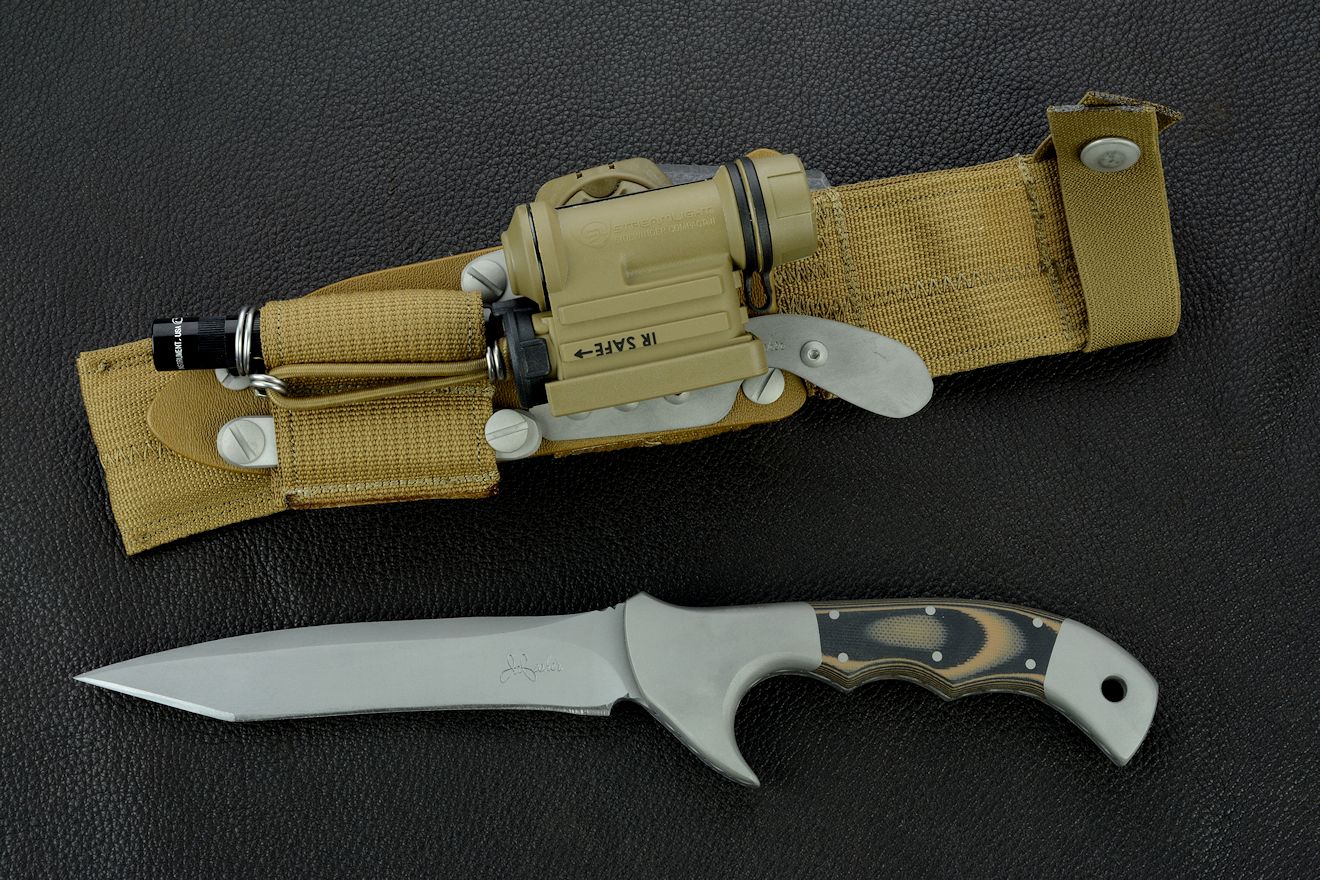 More
More about this "Korath"
Counterterrorism Knife
You might be surprised at who
purchases custom and handmade knives. Just like any other modern
interest, there are varying levels of involvement and interest in
the modern knife client.
- Knife enthusiasts are simply people who are interested in knives. That includes a
tremendous cross section of humanity as every human, sooner or
later, will use a knife. Knives elicit a visceral response from
nearly every human; in every culture they are recognized for what
they are and what they can do. You could not say that about a
fork, a car key, a trivet, or an MP3 player. Knives are universally
known and accepted. This doesn't mean that they are accepted with positive
reactions, and I talk about those trends in my book. What it means
is that the level of interest in owning fine knives is widespread,
and spans cultures, time, and nations. People may become enthusiasts
if they simply own one good knife, but most have more than one.
Anyone who is reading this with interest is probably a knife
enthusiast.
- Professional knife users are people
who must use a knife in their trade or occupation.
This could mean a packer on the line in a slaughtering plant, but
that type of knife is cheap and you won't find any fine custom
knives at a butcher shop (unless he's a very accomplished butcher).
You will, however, find fine and sometimes custom handmade knives in
the hands of a fine chef. You will see well-made knives in the hands
of professional hunting guides and outdoorsmen. You may find
professional knives in the hands of police, SWAT teams, Emergency
Response teams, firefighters, first responders, and Paramedics. Most
significantly for guys like me who make
combat knives, you'll find
handmade and custom knives in the hands of military professionals,
infantrymen, federal officers, police, and combat soldiers.
Professionally made knives are used by combat search and rescue
(USAF Pararescue), survival specialists (SERE), Special Forces,
Navy SEAL Team members, Special Operations, Marines, and Explosives Ordinance Disposal
technicians. These are knives designed with the input of and
used by the some of the top counterterrorism teams in the world. Knives used in these fields must excel in performance,
construction, wear characteristics, and accessibility as lives
can depend on their performance. One of my greatest honors is
making counterterrorism knives for some of the top counterterrorism units in the
world, lives that can literally mean life and death in their wear,
design, construction, and use.
- Collectors are a special
group of people who collect knives because of their interest, the
value, and long term investment potential of the knife. Well-made
knives by world-class knife makers appreciate in value over time,
and most other knives do not. It is not just the increase in
monetary value of the knives that make them suitable for collection;
collectors collect knives because they love them. You can see why on
the many testimonials on this site. The type of knife, the style of
a particular maker, a personal interest, or an appreciation of fine
knife design and craftsmanship are all building blocks for a knife
collector's interest. His interest may be in only a single example
from many different makers, a particular style of knife, or a
long term association with an individual artist who makes the kind
of knife that he likes. As his interest grows and the maker matures,
quite a collection can be amassed and the maker may develop a
substantial following among specific collectors.
Through the interest, support, and patronage
of knife enthusiasts, knife using professionals, and knife
collectors, a maker can continue to produce and grow over the years,
improving his knives, his skills, and his business.
Back to topics

When I started making knives, one could buy the best factory knife made for under $100.00. So most
knife makers started their work at $100 and the prices went up from
there. Now, there are some factory knives that are priced at several
times that. The reasons that custom and handmade knives are more
valuable than factory knives is usually clear when the knives are
put side by side and compared. For an in depth discussion of the
distinctions between factory and handmade knives, I've created a substantial page.
- Materials: though you may read many claims about
the superiority of particular knife materials on the
Internet and in publications, the materials are not the foundation
of the cost and value of a fine handmade knife when compared to a
factory knife or a poorly made knife. The reasons companies and individuals tout their
product materials as superior to others is typically merely an
advertising ploy. Though cheap foreign imported knives are often
made of inferior steels, other metals, and handle materials, many
factories and boutique shops use good steels in their blades and
durable handle materials, yet their knives do not rate of higher
value or investment grade due to many other important factors.
Today, our civilization creates and has access to the finest steels
and materials that have ever existed, and because of information
technology, knowledge about the proper application and use of these
materials is easily obtainable. Though some materials used may be
rare and expensive and may add to the base price of a handmade
knife, they, alone, are not the determinant factor in knife value.
What are these factors? Read about these distinctions on a
special page here.
- Patterns:
Countless patterns of knives, daggers, and swords have existed throughout mankind's
history. Any search of textbooks, historical sources, or on the
Internet will yield many thousands of patterns. At first, a new
pattern may seem novel and unique, but this is rarely the case.
It is not simply the knife pattern that
differentiates value in knives, though it can play an important
role. Read more about patterns, designs, and copyright issues on
my Business of Knife making page
at this bookmark.
-
Fit, Finish, Design, Balance, Accessories, and Service
are the six defining points that usually separate fine handmade
knives in value from mass produced, factory, or poorly made knives.
I go into these points in great detail on a
special page.
Back to topics
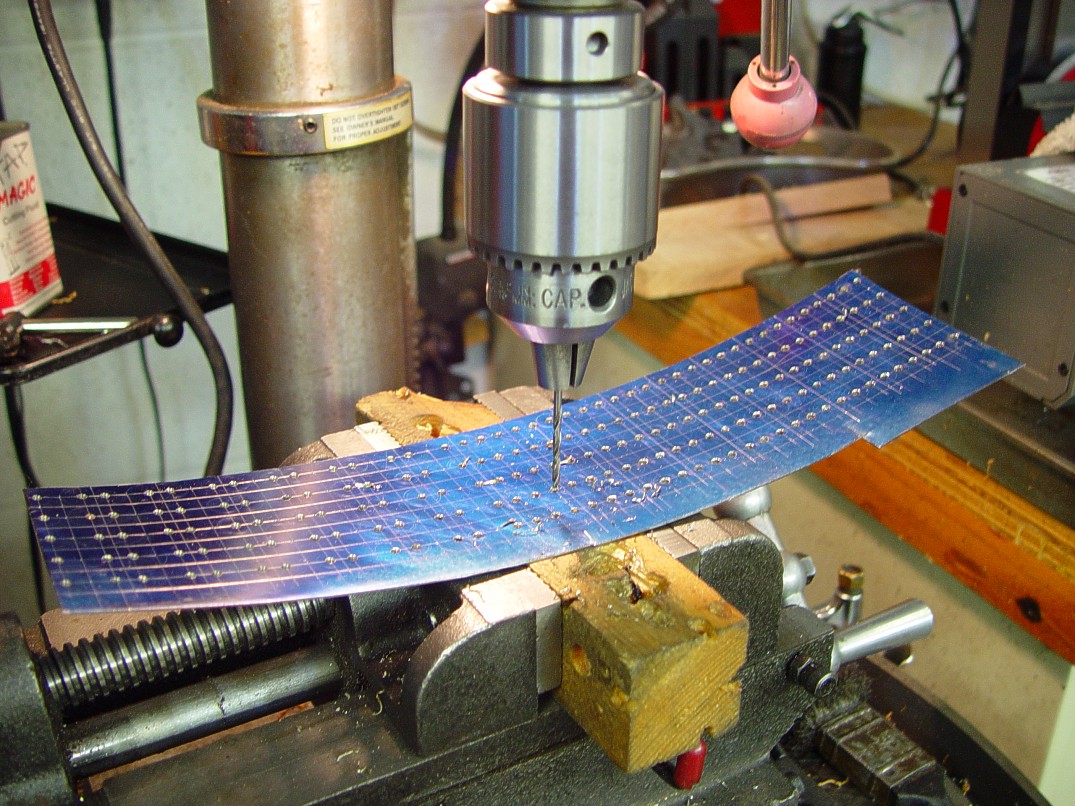
A great deal of knifemaking is understanding the relationship,
manipulation, combination, working, and finishing of a great variety of
materials. You could say that knifemaking is perhaps the most wide
ranging materials craft known. If you don't believe this, lets do some
simple comparison:
- A jeweler works in precious metals, and so does the knifemaker.
But the jeweler does not work in wear resistant, high strength tool
alloys, and no jewelry is meant to be a working tool. Rarely do
jewelers work in woods, even less so leather, and jewelry is
relatively small in size and not really expected to perform (apart
from buckles). While a jeweler may work with stone, rarely does he
work with any stone large enough for a knife handle, case, box,
sculptural stand component, or base.
- A carpenter or cabinetmaker works with hardwoods and joinery,
shaping and finishing, and may rarely work in supportive metal
structures. But he does not typically work in tool steels,
super exotic woods that can only be acquired by the inch, and
he doesn't work with any leather, plastics, or manmade materials.
- A shoemaker works with leathers, but does not work with hardened
high alloy metals, engraving, or metals machining.
- A machinist works with tool steels, but does not work with
leathers, woods, or embellishment.
II could go on and on, examining and comparing the materials sets of
various art and craft processes, and it's easy to see that a painter,
ceramics artist, photographer, woodcarver, clothing designer, sculptor,
and graphics artist all have a bit of the knifemaker's trade in them,
but the knifemaker, the truly dedicated knifemaker, has some of all of
their skills in his toolkit. To give you an idea of how this all works,
consider this:
- Programming, IT, Computer Technology: as a
knifemaker, I start with a functional coded, website, and actively
use computer technology for conversation, research, illustration,
and completion of all of the aspects of the public part of my
business. What you are reading right now is coded, by hand, in XHTML
markup language by hand. While I've removed the more complicated
parts of the coding, PHP and MySQL, computer science plays a big
role in what I do.
- Photography: If you are like me, you take every
single photograph of your knives, archive them, arrange them,
present them to the public for inspection and record. This also
includes shop photos, process photos, and even photos to record
arrangements of tooling so I know how to repeat a particularly
difficult setup in the machinery.
- Drawing, Painting: all good projects start with
drawings; drawings compose the subtle nuances of blade design,
fittings arrangement and are the basis for all stands, cases, and
displays. They are also the basis of all embellishment, engraving,
detailing, carving, etching, and designing. Painting is done in my
trade with micro-brushes and leather dye, in gentle layers of
toning, density, color, and saturation for a special appearance on
sheaths, stands, or cases.
- Toolmaking and tool steels are obvious players
in the knifemaker's toolkit, and he needs them not only to make his
blades, but also to cut them, mill them, drill them, and shape them.
A machinist is a major job requirement of the successful knifemaker.
- Woodworking is a major player not only in knife
handle construction, but also in blocks, stands, cases, and
displays. Understanding how wood works, moves, shapes, and finishes
is critical because rarely is one single wood type used in these
projects; I remember one of them I made that had ten different
species of wood in the finished product.
- Leatherworking is an obvious skill set that
makers like myself who make their own sheaths must excel in. This is
not a decorative belt or handbag project; these are heavy duty
holders for razor keen implements that must protect the wearer with
logical and sturdy design, hardened construction, and striking
beauty. In addition to cow hide, the successful leatherworker in
sheaths must understand exotic skins and how to use them. Carving,
tooling, and hand-dying are also necessary skills.
- Manmade materials craftsmanship and
applications are critical to understand in the knifemaking world.
Loosely called plastics, these materials comprise modern polymers,
phenolics, polyesters, and poly-epoxide thermosets as well as
pressure stabilized hardwoods and organic materials. Handles can be
constructed of the most durable of these materials, and sheaths,
fittings, and accoutrements require their use along with metallic
hardware and an understanding of how the two combine and interact in
the entire assembly. Textile applications of nylon, polyester,
polypropylene, and even Teflon are required in military combat gear.
- Lapidary is a rare application, but in my
distinct tradecraft, it is a major player in the completion of my projects.
Lapidary requires a very wide skill set, as rock, stone, and minerals
are some of the most tenacious and labor intensive materials to work
and finish.
- Chemistry is not often considered part of
knifemaking, but it plays a heavy role in the versatile knife
studio. Etching, plating, soldering, anodizing, passivizing, bluing,
and chemical staining are essential processes to understand and
effectively apply in modern knifemaking.
- Sculpture is seldom considered as knifemaking,
but this is really the essence of knives, as they are three
dimensional objects. The knife doesn't just need to look good
sitting there, it must be held, be comfortable, even inviting to the
human hand, while being beautiful and unique. All this while
performing the sometimes forceful task of cutting, ripping, and
carving. Add to this the advanced knife artist creates sculptural
stands, fittings, and displays and you might find him sculpting in
clay, wax, or other media and hand-casting the display sculpture in
bronze. I do! I know of no other objects made by man that fit this
profile.
Wow! Who knew there was so much to being a knifemaker? Add to this
the essential skills that go on behind the knife; machine tool
construction and repair, electrical repair, maintenance, and invention,
HVAC, safety process, jig and fixture component construction, and all of
the typical things it takes to run a business, finance, and accounting, and the skill set can be
significant!
This is why I love this job. Always something new, always a
challenge, and always a thankful reward for the most important thing
applied to any work of fine craft or art: labor of the artist's
hands guided by the brain God was kind enough to supply.
Back to topics
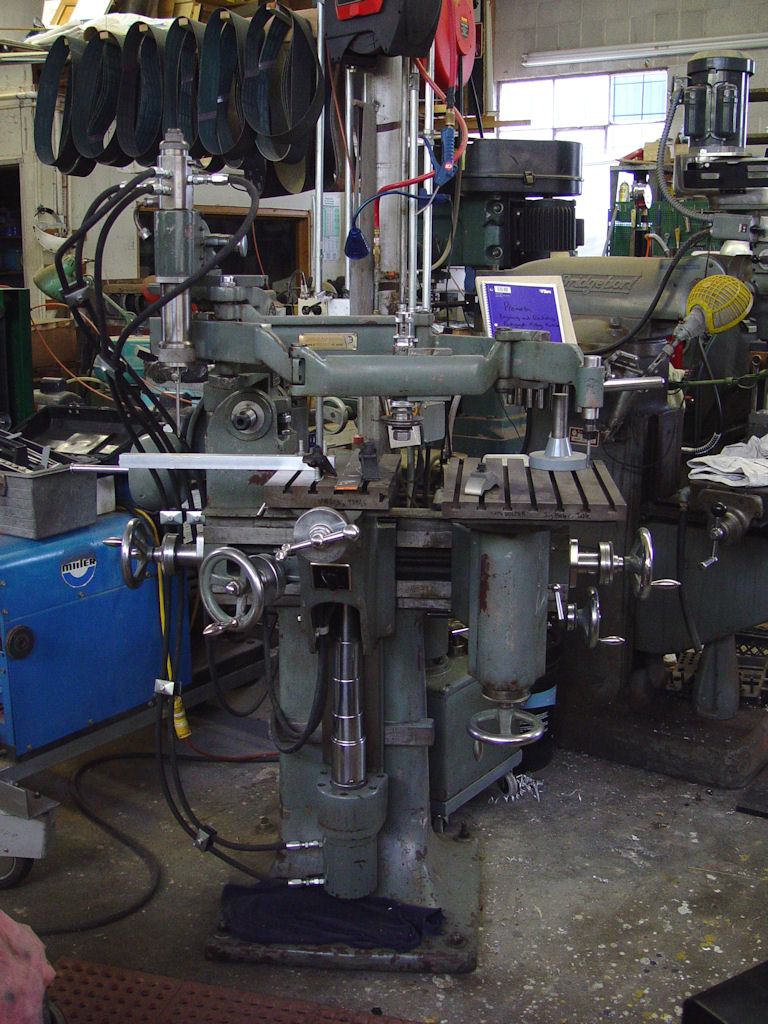
A simple, hand-operated three dimensional engraving and die-sinking milling machine
It is the material that determines the maker's methods and techniques; the most refined materials
require the most specific and controlled methods. Lesser materials
can be handled with casual attention.
What is the difference between a blade smith and a stock removal
knife maker?
The fact that a knifemaker is hammering out red hot metal on an anvil indicates he is using an inferior, low alloy tool steel.
The highest quality blades with the highest performance cannot be hand-forged.
People who buy the idea that a hammered blade is somehow superior to high alloy tool steels are buying the
false image, not the reality.
The two names below describe how the knife maker
makes the knife blade. Though I've hand-forged knife blades in the
past, I currently make by the stock removal (hand-guided machining) method because it allows
me a higher quality, better performing, and greater range of high alloy tool steels.
- The blade smith (or Bladesmith) uses
time-honored techniques of hammer and anvil, and forges a blade
using heat in an open-air forge and process. In this day, he may use power hammers, gas forges, and
modern methods and techniques, but his blades are hammered out of
stock, or heat-forged and welded from various steels. He is not
usually limited to size and shape of his blades, but is limited in
the types of steel he uses. He can only use low alloy
steels and plain carbon steels. High alloy tool steels, martensitic stainless steels, and steels that have high critical temperatures are not
hand-forged, because they can not be exposed to free oxygen
during temperatures at which they can be forged or decarburization
will occur, drastically effecting the steel make-up, internal
stresses, and thus performance. Also, open air forging furnaces are not
capable of maintaining the extremely high temperatures at which
forging of these high alloy steels could occur. Most of the high
alloy tool steels can not be hand-forged, so you will not see them
offered by blade smiths. What you will see are plain carbon
steels like 1025, 1095, and 5160. You'll occasionally see steels
like D2, but if this steel is hand-forged in open air, significant
decarburization will have occurred, severely affecting performance.
In reality, hand-forged D2 is ruined steel. You may see some
stainless steels hand-forged, and this is possible on the lower
alloy types, but performance of these alloys are considerably
limited, making one wonder why the are hand-forged in the first
place. The
low alloy carbon steels have severe
limitations of wear resistance, corrosion resistance, and tensile
strength, but because they are easily forged, forgiving of
error, and cheap, many blade smiths use
them. The main reason that these lower alloy types are
hand-forged is because of a certain look, the look of pattern-welded
damascus, a temper line (hamon line) and appearance only. These
knife blades are created this way because it can be done in a fairly
inexpensive method (no high temperature furnaces, cryogenic process
equipment, or high accuracy tempering ovens are required), and the
visual appeal only is the desired effect. This is the only reason
(visual appeal) that I have and do use this technique and material
for some blades, at the significant cost of lower performance. More
about the failings and limitations of
damascus steels here.
- The stock removal knife maker makes
blades by cutting, shaping, grinding, drilling, machining, and milling stock
steels, followed by heat treating (hardening and tempering) in
controlled-atmosphere furnaces. This is followed by finishing steps.
Generally, he does not hammer forge his blades, but some hand-forging may occur
of fittings and accessories.
The advantage of stock removal is tremendous. High alloy, exotic, and
refined modern
tool steels can be used to make his blades, and these are some of
the finest alloys and metals available in the world today. Heat
treating is done in an oxygen-free or oxygen-reduced atmosphere in
the high temperature accurately controlled environment necessary to heat
treat these steels. The maker can and should use cryogenic
process and equipment to handle these steels, and follow heat
treatment and cryogenic quenching and aging with deep cryogenic
thermal cycling between tempers. Tempering is specifically
controlled in a high-accuracy oven designed for a laboratory
environment. The stock removal knife maker may be limited by
the size and shape of the stock he uses, but nowadays, this does not
have to hinder his creativity. For example, I use a high tech GTAW
welder to create the pieces I need out of very large or wide stock
when necessary, and the technology of the welder, the alloys, and
the heat treating process yields an isotropic, uniform blade of
monolithic high alloy tool steel. Most of my military, professional,
counterterrorism, and collecting clients request these fine steels, because they are
far superior to plain carbon steels in wear resistance, tensile
strength, and corrosion resistance. They are always, always
superior in performance to damascus pattern welded steels which are
created only for appearance. They are, simply put, the best
steels made. More
at this
bookmark on the Blades page.
- Which is preferred? The
techniques and materials are different, and the differences are
significant due to the different steels available for use, and
his control and utilization of the process, based on his experience. Each knife maker must prove his qualifications and
ability with each individual knife depending on components used and
the six distinctions I
listed in the previous topic. Each type of knife making has
its following, its purists, its enthusiasts and its opponents.
I have good friends in both camps, each has a respect for each
other's abilities and skills. Often, each type of maker may cross
over in techniques of blade creation. No matter how the blade is
created, it's important that the knife maker make his own blades,
that they are not farmed out or bought from suppliers or as kits.
Otherwise, he is not a knife maker, but a knife assembler.
- Definitions: It is interesting to note that the
definition of forging is to form by heating and hammering. It
is also defined by shaping metal by mechanical or hydraulic press.
Another definition is to form, shape, or produce in any way. So
when a factory claims that its blades are forged, it may simply mean
that they are stamped out on a die press, which is, technically,
not a lie. Shaping metal by mechanical means could also define
drilling a hole in a piece of metal, so that, too, could be called
forging. Please think about this when you read advertising copy or
vague descriptions of process. This is in every standard
dictionary.
- Differences: No matter the method of the initial creation of
the blade, the blade must be ground, drilled, machined, and finished
in high quality works. Also, bolsters, guards, handles and
sheaths must be constructed, and embellishment in finer pieces must
happen. After blade construction, both the blade smith and the stock removal knife maker have
more in common than in difference.
Back to topics
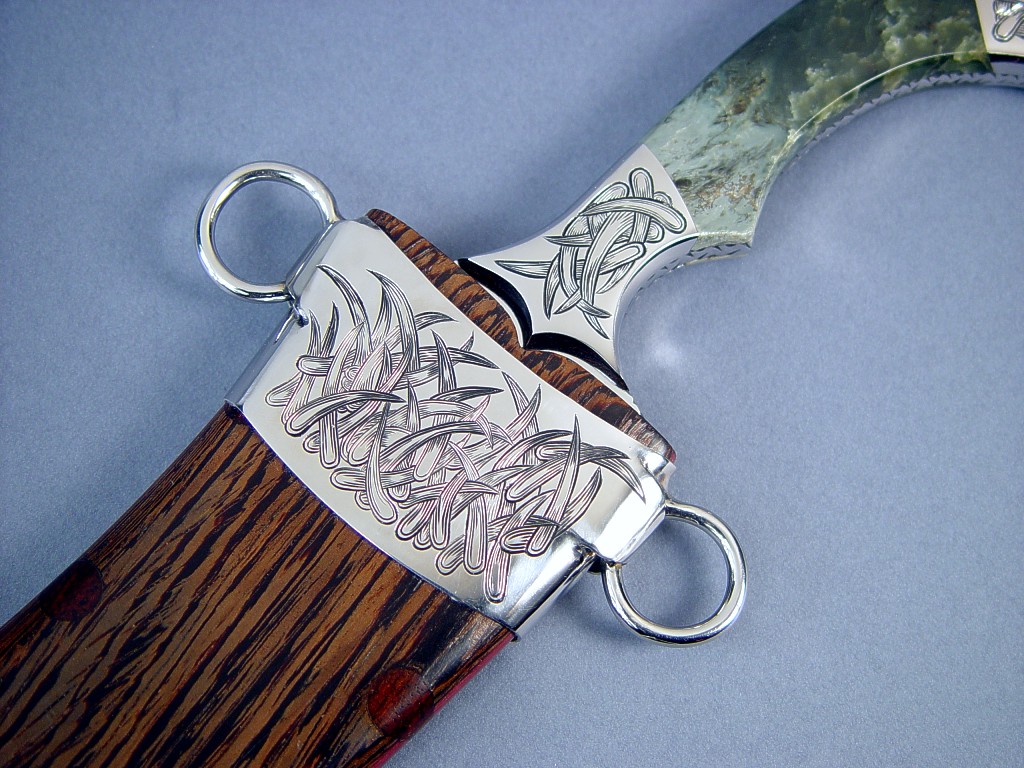
When thinking about modern tools and technology in knifemaking, there is a natural progression from hand-forging low alloy carbon steels to machining high tech
high alloy steels. The technology then focuses away from the handwork and onto the
machine work. Because machines themselves are technological wonders, and new devices and
operational methods are being developed all the time, the machine becomes such a central part of the work that, at some point, it overcomes the product!
This is true in many fields, and knifemaking is no exception. Take,
for instance the belt grinder. It's a very simple machine, a motor
driving a wheel that drives an abrasive belt around other wheels. The
nuance of the machine is not in the wheel arrangement or accessories,
it's in the hand of the guy that holds the blade against the abrasive.
He controls what is happening via his bare hands, thus, the
machine enables speedy work of hand-grinding. Like all human endeavors,
the idea pops up to make the entire affair, well, easier. After all,
hand-grinding is hard work, and it doesn't always come out right. So the
knifemaker may try jigs and rigs, and devices and contrivances designed
to make the job of hand grinding easier, more predictable, and faster.
In the decades I've been making, I've seen every type of device made to
do this one simple step in hand-grinding, and as yet, not a one of them
is worth the time it takes to bolt them on the tool rest.
The reason is simple. The human hand, when trained and skilled, can
sense, adjust, and correct an incredible amount of geometries, angles,
directions, pressures, an movements, all instantly. A jig simply holds a
blade and allows it to be moved side to side. The jig cannot create a
radiused hollow grind, cannot create varying angles and thicknesses
along a curved blade length, and cannot accommodate a recurved hollow
grind that is narrower than the belt. Worse still, a jig cannot create
subtle differences in pressure, direction, and flow that allows ten
steps of increased grit size for proper and accurate mirror polishing.
This is why very few knives are mirror polished at all, and of those,
fewer still maintain accurate geometry that is not destroyed by an
overzealous buffing wheel.
Learning this stuff is hard. The guys that I teach in my studio can
tell you just how difficult it is, and also how valuable this skill and
its results are to a patron and client. Rather than study and train for
years to achieve this result, craftsmen continually search for an easier
way. The truth is, if it were easy, everybody would be doing it, and
then it would have little value. But the search continues in an effort to shorten,
quicken, and improve the work, and because we are enamored with the
machine, we try to build and use more complex machinery to do this work.
The CNC machining center is a good example of this. The machine uses
the logical commands programmed into a computer to establish a set of
functions for the machine to execute in order, and the human hand has
little to no contact in the operation. Machined parts can be cut,
drilled, milled, ground, shaped, radiused, slotted, and created almost
wholly under the changing turret of cutters. The advantage of this is
tremendous speed and uniformity of operations, so the machine is
well-suited to production. Naturally, knifemakers are all about
production, so one of these sounds like a great solution.
If this were true, we artists and craftsmen would be out of business!
But we are not, and there are some simple reasons that the answer is not
always in the machine. It comes back to that human touch. The machine
cannot apply this, no machine can. It is the union of the machine with
that variable, adjustable sensitivity that allows microscopic tweaks of
movement and pressure to create flowing, finished, and artful forms,
forms that simply don't look like they were cut out by a machine. And
that is really all you get with a CNC: forms cut out by a machine. The
total piece then becomes an assembly of parts that all look like they
are cut out by a machine, and because machines mass-produce, the value
is low.
There is a type of consumer, however, that is more enamored with the
process than the creation. He would rather describe to his friends the
complexities of the computer-driven process and the
big machining center that milled the knife than the knife itself. After all,
it's flatly ground, squarely jimped, with all parallel surfaces, and a
flat and lifeless surface, which wouldn't even be called a "finish."
Some are step-milled, in a machine attempt to build a hollow grind that
ends up looking more like a set of stair steps than a blade grind. Perhaps
the blade is sprayed with paint and baked. Perhaps it has bolted-on
handle scales with three simple rivets or screws down the centerline.
And it may not even have a functional sheath. But the machine that made
it... well, you just won't believe it; it's a magnificent work of
technology!
I don't use the newest and fastest ultra-modern computer driven
technology in my studio. This tech actually would limit what I do,
because nothing can replicate the creations of the human hand, eye, and
touch. If it did, I would be out of business! Since this shows not the
slightest hint of happening, I can only surmise that the role of the
human hand has not been supplanted.
In recent years, great advances have been made in machinery,
particularly with computer interfaces and control, and we all
certainly hope that they can help us create a wider range of specialized
items. But for now, the operations of a machine limit what can be done,
they don't extend it, amplify it, or improve what can be done by skilled
hands. And a knife made by a machine is less in value, appearance, and
desire, than what is made by hand.
Back to topics
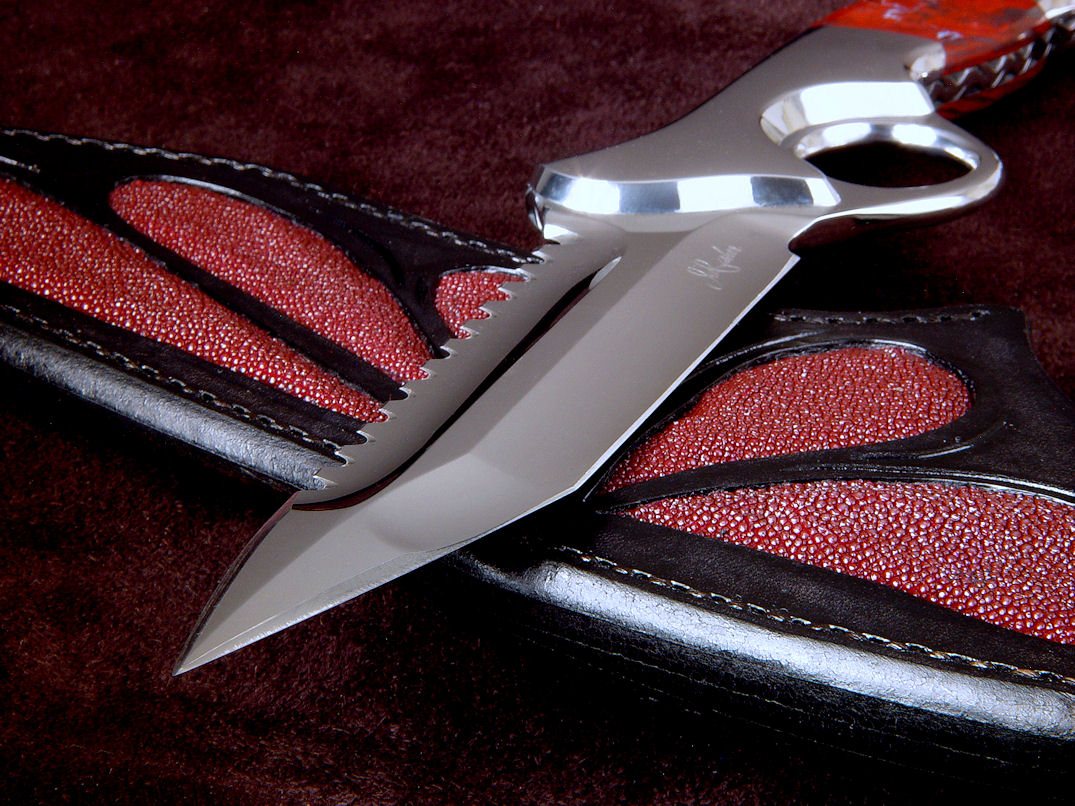 More
More about this Israeli Defense Force YAMAM Unit "Ari B'Lilah" counterterrorism knife
Seems simple, right? It's a knifemaker who does this as a profession,
as his main, full-time source of income, officially, legally, and in a
business environment, right?
I've read several online sources, discussions, and articles about "Professional" Knifemakers, and there seems to be a lot of confusion and misplaced
descriptions about what constitutes a professional knifemaker. I'll get into the reason that this is a confused title and I hope that for the sake of the
knife client, owner, patron, or customer that this section will help clear that up.
In this context, the word professional typically means that
a professional knifemaker does this for a living, as a profession, and this is his main
and central focus, way of earning a living, and is registered legally
and officially by
local, state, and through the federal IRS and governmental agencies as an
occupation. A professional, then is a full time, occupational
knifemaker.
A part-time knifemaker is not a professional knifemaker, nor is a
hobbyist, amateur, or person who simply likes to make knives. There are
all sorts of uses for the word professional, such as acting
like a professional, having professional standards, or being in a
profession. Perhaps this has confused the identity of the professional
knifemaker, and frankly, everyone, from amateur hobbyist to part-time
knifemaker wants to call himself a professional, because doing so paints his
practices and skill as, well, professional! This is done for one reason, to
portray
a picture of one as better than they are, because it's assumed that a
professional occupational knifemaker will have a greater understanding,
knowledge, and skill as a craftsman, tradesman, artist, and business
professional. But calling yourself a professional for these reasons is
frankly disingenuous, inauthentic, and lacks integrity.
How to tell:
The person who claims to be a professional knifemaker would (by law
in the United States) have these essential and critical items and
traits:
- A Federal EIN (Employer Identification Number)
is absolutely required nowadays by every professional
business; there simply is no way around this. If one is a hobbyist,
part-time knifemaker, or amateur, the determinant factor is often
this very number. This number means that the professional business
files a Schedule C IRS form (Profit or Loss in a Business) and is
federally registered, and regulated, indexed, and identified by the
United States government.
- A business license
is typically required by the state in
which the professional is located. This is critical to define,
regulate, tax, and inspect any business, in any state. It defines
the business and typically registers its name and location. It's also used to
access tax information, filing, and other business essentials
defined by the individual state. In our state, it requires us to
collect state taxes on any in-state sales.
- A business registration, accessible by local
authorities and jurisdictions. This may vary somewhat, but usually
any person doing any kind of business is required this. Cities,
towns, and counties typically require this for any professional
occupation, and it's fairly easy to look this up in the local
business directories of those entities.
- A certified, inspected, and unique business address
and storefront is usually required by professional
businesses. Certainly, when a part-time maker is working in his
garage, this is not the case, but a part-time maker working in his
garage is not a professional, either. While the part-time maker may
be required by zoning and local laws to have a state business
license or local business registration, there is a level of
commitment that may be in question when a client considers the
environment where a knife is made. Without a professional business
address and storefront, the official entities (Local, State,
Federal) can and do question whether this is a hobby, an interest,
or a profession. Some professionals work from home, but rarely does
a home contain a professionally outfitted, full time
knifemaking shop or studio.
- Full time employment as the main source of
income is the determinant factor that most official entities use to
certify, regulate, and classify a professional. Since there is no
standard of education or certification for what constitutes a
professional knifemaker, the full time employment distinction is
essential for official and legal identification. While it may be a
difficult issue for the client to determine, it's clear to federal,
state, and local authorities where the knifemaker's money comes
from, how much of it he makes, spends, and invests in knifemaking,
and this is what makes these legal authorities license, accept, and
classify the business. It is a business, and sooner or later, the
professional business aspect will be clarified, after all, it's the
law.
Other related items not necessarily required but important to the
knife client, patron, or customer that accompany a professional business
are:
- Visitation by the client. If people
are not allowed to visit the studio or shop because the location is
residential (typical in part-time knifemaking), this also suggests
the non-professional, non-occupational method of knifemaking.
Visitation may be tightly controlled or restricted (mine is,
conforming to local laws), at least the client knows exactly where
(and how) his knife or knives are made.
- A business and professional bank account is
necessary so that business related transactions are conducted
separate from personal accounts. Bank transfers, credit cards,
payment methods and other business transactions are conducted in the
scope of dedicated professional means. This goes hand-in-hand with
the Federal registration and business codes require above, and
reassures the client that the professional business is on good
foundation with an established financial institution.
- A functional, detailed website is absolutely critical in today's
professional business world. I've stated before that most
professionals will have this curriculum vitae available, and today's
method is through the internet. Curriculum Vitae means "a brief account
of a person's education, qualifications, and previous experience,
typically sent with a job application." You may not think this
applies, but consider that if you are going to buy a knife, you will
be employing the individual knifemaker, and therefore, your contract
together is an agreement that the knifemaker works for you. Every
knife made and sold is a job application. If I, as a singular
professional knifemaker can provide hundreds of pages of detailed,
researched text, tens of thousands of photos of made and sold
knives, hundreds of testimonials of satisfied customers on this very
website, there is no reason that any other knifemaker who calls
himself a professional can not and will not offer this insight into
his professional business. Maybe other professional makers aren't
able to offer this type of illustration, but let's cut this down to
10% of what I do. With only 10% of what you see here, that would
mean a professional knifemaker's website will have at least 50 pages
of related data and about 700 unique, original photographs. Again,
this is not a requirement, just an indicator of the professional
standing of the knifemaker being considered by the client.
There is a lot more to this, and I'll go into it in great detail in
my book, but guys will take the name "professional" and interpret it to
mean something else that justifies the title for themselves, and this
can be quite humorous. I've seen discussions that claim that if the
maker can grind a bevel (technically called a grind or hollow grind),
fit a handle, dovetail a bolster, and tightly fit a guard, he can call
himself a professional. I've also seen it written that if he buys 50
sheets of sandpaper at a time, he's a professional. I laugh at the claim
that if a knifemaker has a bathroom in his shop, he's a professional. I
hope these are seen as "trying to make knives in a professional way,"
and not the statement that these simple comparisons are what constitutes
a full time professional occupational knifemaker.
A professional knifemaker is one whose main
or sole source of income is making knives and their related
accessories. He is registered and accounted for by Federal, State, and
Local authorities, has a professional business storefront, and an easily
accessible reference to his works, method, and business practices for
whatever time he's been making. A higher level professional is sought
out for his knowledge and experience in the tradecraft by businesses,
persons, organizations, and official entities to advise in an expert
capacity, as a Professional Knife
Consultant.
Patience, willingness to learn, and dedication
alone do not make a professional.
Full time employment, scope and detail of applied knowledge,
specific legal requirements, and clear record of achievement and
experience make the professional knifemaker.
Conduct is the determinant factor.
Nature has made occupation a necessity to us; society makes it a duty; habit may make it a pleasure.
--Edward Capell
1713-1781
More about what constitutes a professional and the standards associated with this declaration on my Business of Knifemaking page
at this bookmark.
Back to topics
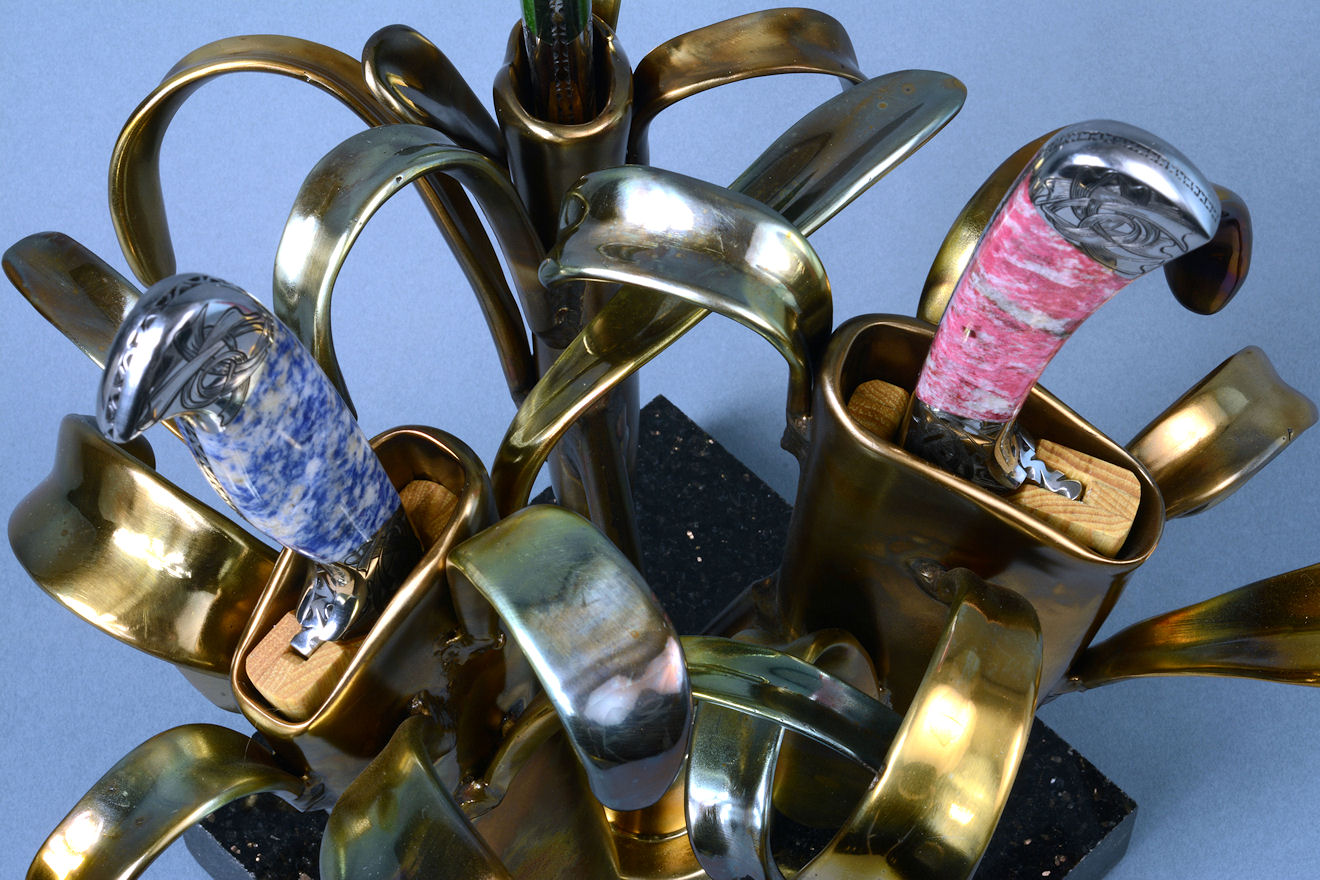 More
More about the "Antheia" Chef's Set
Modern knife making has progressed dramatically in the decades I've been involved. Steels
have improved, as have abrasives, computers, adhesives, and communication which allows you
to see the many knives available and read plenty of information on this topic by guys like
me who do this for a living. This very site is a service that I had not envisioned as useful
or available when I started seriously making in the early '80s. It is
now not only essential for
my business, but also my sole business attribute. I no longer take dangerous and
arduous trips to shows and exhibitions; I create my own knife show on this very website. Communications and
web technology allows me access to new materials, design ideas, process information, and suppliers.
It is the new medium of knife making. Where else can over two million people see my knives in the course of a
month? It's a fascinating and exciting field, and I'm proud to be a part!
Back to topics
